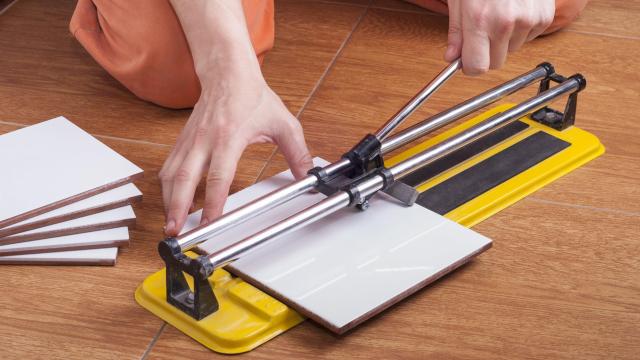A small tile project like a backsplash can be a DIY project — as long as you have the right tools. However, tiling jobs — including that backsplash project — often call for a wet saw to accurately (and safely) cut the tile. A wet saw provides a steady stream of water over the blade to create smooth cuts and reduce the level of dust or debris that high-powered cutting would produce. Unfortunately, wet saws can cost anywhere from about $100 to nearly $400 to buy and can be a bit overwhelming for a beginner to use. If you aren’t ready to make that jump, there are other ways to cut the tile for your project.
Here’s how to complete your next tiling project — without using a wet saw.
How to use a manual tile cutter
For larger straightedge cuts, a manual cutter will get the job done. Manual cutters use scoring and pressure to snap the tile at the desired size. The cutter is made with a base to hold the tile, a handle rod on two metal tracks that scores the tile, and a pressure plate that snaps it into two piece. They are fairly inexpensive, costing about $30 for a moderate quality cutter. If you want to cut thicker porcelain or glass, a better equipped manual cutter will cost around $160).
Before you begin, you’ll want first to mark where you want to make your cut. Then, place the tile on the cutter base and line it up with the small wheel blade attached to the handle rod. After you’ve got it lined up, bring the handle down and push forward, so the blade runs along the tile marked for cutting. This part of the process is not cutting the tile through but cutting deep enough for the next phase to break it to the proper size.
Once you’re at the end of the tile, press down on the handle to apply pressure (no need to press hard; the metal plate will break easily), and the tile will snap along the line you scored. Watch YouTuber See Jane Cut for a visual example of manual tile cutting.
After cutting your tile, you may need a rubbing stone to smooth out any rough edges, but those are easy to find and inexpensive. This method is great for cutting porcelain and ceramic tile in straight lines. Unfortunately, though, manual cutters cannot cut through stone or thick ceramic tiles, and they can’t make small or curved cuts.
Using a glass cutter for tiling projects
A glass cutter uses the same method as the manual cutter, but ironically, you’ll manually apply pressure to break the tile yourself. First, measure out and mark the area that needs to be cut using a pencil and a T-Square or yardstick. Bob Vila recommends setting the T-Square or yardstick slightly off the mark to make room for the cutter to hit the appropriate spot. Then, run the cutter along the line using the T Square or yardstick as a guide to stay straight. Press down so you hear the scraping sound of the blade hitting the tile to score it.
After scoring the tile, take the other end of the glass cutter (which should have a small round ball at the end), and gently knock the bottom side of the tile along the scored line. This action will further weaken the line to allow an even break. Then, take a wire hanger or the glass cutter itself and put it under the tile’s cut line; the cutter or hangar will prop the tile up. You’ll then press down on either side of the cut line to snap it in two.
A glass cutter is a cheap option, starting at just under five dollars, but similar to the manual cutter, this method only works for straight cuts and porcelain or glass tile of average thickness. If you want to make angled cuts or minor cuts for corners, you can use a tile nipper and rubbing stone.
No matter what you use, though, make sure to wear protective glasses at all times — tile debris can be dangerous, especially when using manual or glass cutters.

Leave a Reply
You must be logged in to post a comment.